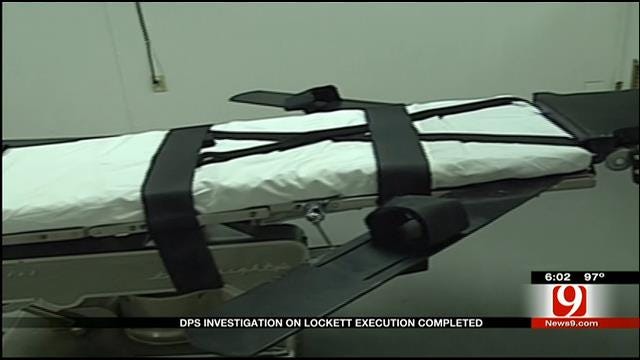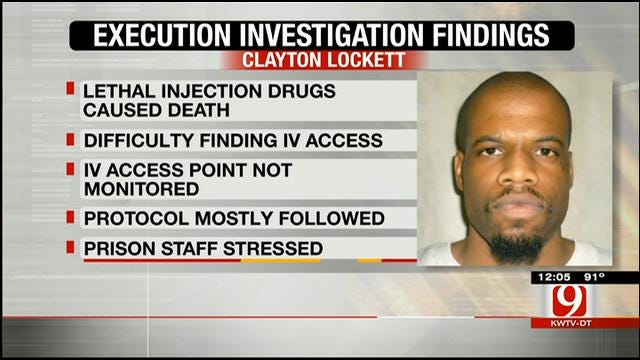DPS Releases Findings Report In Clayton Lockett Execution
According to the findings, authorities believe the IV access was the major issue with the execution. The IV failure complicated the ability to determine the effectiveness of the drugs.Thursday, September 4th 2014, 10:58 am
State officials announced the completion of their investigation into the execution of Clayton Lockett Wednesday. Investigators posted their findings report at 9 a.m. Thursday on the Department of Public Safety's website.
Based on the autopsy, Lockett's cause of death was listed as Judicial Execution by Lethal Injection. The manner of death was listed as Judicially Ordered Execution.
According to the findings, authorities believe the IV access was the major issue with the execution. The IV failure complicated the ability to determine the effectiveness of the drugs.
5/2/2014 Related Story: DOC Releases Timeline Of Clayton Lockett's Execution
Following is a summary of the findings made by Southwestern Institute of Forensics Science (SWIFS) in Dallas, during their examination of Lockett's body and additional information obtained by the investigation team from SWIFS or through the investigation:
Judicial execution with:
a. Execution protocol medications used: midazolam, vecuronium and potassium chloride.
b. History of difficulty finding intravenous access sites resulting in numerous attempts to start an IV.
c. Attempts in both antecubital fossa, both inguinal regions, left subclavian region, right foot and right jugular region.
2. Superficial incised wounds of the upper extremities consistent with history of self-inflicted incised wounds with a safety razor.
3. Contusions and abrasions of extremities.
4. Cardiac hypertrophy (480 grams)
5. Mild coronary artery atherosclerosis.
6. Hydroxyzine detected.
a. Lockett was prescribed hydroxyzine, but the prescription had ended March 3. There were emails from DOC personnel alleging Lockett had been hoarding medication. SWIFS personnel stated there were higher than therapeutic levels of hydroxyzine present in Lockett's system and hydroxyzine should not have interfered with the execution drugs administered. They also could not determine when or how much of the hydroxyzine was taken.
7. No evidence of dehydration.
8. No Taser marks on the body.
9. Toxicology indicated elevated concentrations of midazolam in the tissue near the insertion site in the right groin area, which is indicative of it not being administered into the vein as prescribed in execution protocols. The presence of midazolam in the psoas muscle indicates midazolam was distributed 14 throughout Lockett's body during the execution. According to SWIFS pathologists, the concentration of midazolam located in Lockett's blood was greater than the therapeutic level necessary to render an average person unconscious.
10. Vecuronium bromide was found in the femoral blood sample taken from Lockett's body. The presence of vecuronium bromide in the psoas muscle indicates vecuronium bromide was distributed throughout Lockett's body during the execution.
11. Potassium was found in the femoral blood sample taken from Lockett's body.
Read the complete findings report here.
Regarding whether DOC correctly followed their current execution protocols, authorities determined there were minor deviations from specific requirements outlined in the protocol in effect on April 29. Despite those deviations, it was determined the protocol was substantially and correctly complied with throughout the entire process. None of the identified deviations contributed to the complications encountered during the execution.
According to the document, the physician and paramedic made several attempts to start a viable IV access point. They both believed the IV access was the major issue with this execution. This investigation concluded the viability of the IV access point was the single greatest factor that contributed to the difficulty in administering the execution drugs.
According to the findings, during the execution, Warden Anita Trammell decided to cover Lockett's body with a sheet, including the IV insertion area, which, according to her, was normal in all executions. Another reason for her decision was to maintain Lockett's dignity and keep his genital area covered.
From that time, no one had visual observation of the IV insertion point until it was determined there was an issue and the physician raised the sheet. Warden Trammell acknowledged it would be her normal duty to observe an IV insertion point for problems. She believed if the IV insertion point had been viewed, the issue would have been detected earlier.
The physician added that an IV would normally be monitored by watching the flow of the IV line and the area around the insertion point for any signs of infiltration. This investigation found that neither of these observations occurred, which led to the issue being discovered several minutes after the execution began.
The autopsy indicated elevated concentrations of midazolam in the tissue near the insertion site in the right groin area, which was indicative of the drugs not being administered into the vein as intended. Thus, the IV access was not viable as early as the administration of the midazolam.
8/28/14 Related Story: Autopsy: Clayton Lockett Died From Lethal Drugs, Not Heart Attack
According to the document, the investigation could not make a determination as to the effectiveness of the drugs at the specified concentration and volume. They were independently tested and found to be the appropriate potency as prescribed. The IV failure complicated the ability to determine the effectiveness of the drugs.
The report says it was apparent the stress level at the Oklahoma State Penitentiary was raised because two executions had been scheduled on the same day. This was the first time since 2000 two offenders were scheduled to be executed the same day.
The Department of Public Safety made several recommendations to the Department of Corrections for future executions. After the Warden admitted a problem with the IV could have been detected earlier, the Department of Public Safety recommended:
The IV catheter insertion point(s) should remain visible during all phases of the execution and continuously observed by a person with proper medical training in assessing the ongoing viability of an IV. This person should remain inside the execution chamber during the entire process.
Also, after one hour of unsuccessful IV attempts, DOC should contact the governor to advise the status and potentially request a postponement of the execution.
Due to the lack of training and keeping of logs prior to the execution, the Department of Safety recommended:
The information to be recorded on execution logs should include, but not be limited to:
a. all statements or behaviors that could be detrimental to completing an execution;
b. all meals provided to an offender and what portions of the meals the offender consumed or refused.
c. all medication provided to an offender and the observations made by personnel as to whether the offender ingested the medication as prescribed;
d. all liquids consumed by the offender
The Department of Safety also recommended additional execution supplies:
1. DOC should obtain from the selected pharmacist, one complete, additional set of each execution drug being utilized for an execution to be used in the event an issue arises with the primary set.
2. DOC should consult with appropriate medical personnel to determine any and all supplies or equipment necessary including, but not limited to the following:
a. Heart monitoring equipment;
b. Venous ultrasound equipment;
c. Appropriate needle/catheters to coincide with th
e. IV access options listed in protocol.
The Department of Public Safety held a news conference Thursday morning concerning the results of the investigation. Commissioner Michael Thompson said during the conference that the report was finalized Wednesday night, and that in the end, investigators determined the drugs were working as expected.
Commissioner Thompson also said the process was designed for the drugs to go into the veins,but the drugs probably took longer to work because they went into the tissue.
Governor Mary Fallin will hold a news conference concerning the results at 2:30 p.m.
Megan McCracken with the Eighth Amendment Resource Counsel, Death Penalty Clinic at US Berkeley School of Law released a statement in response to the state's findings.
“Oklahoma's summary report regarding the botched execution of Clayton Lockett provides some important information about the Department of Correction's many failures that led to Mr. Lockett's prolonged and gruesome death. These failures include a complete lack of adequate planning and preparation for the execution, the inability to set a functioning IV, a breakdown in communication between DOC officials and the execution team that the execution was called off when it became apparent that Mr. Lockett was conscious, and the inaction on the part of the DOC to even try to stabilize Mr. Lockett after Director Patton called off the execution.
Together, the many failures demonstrate the Department's culture of carelessness and inattention to detail and their rush to get the execution done. But the report treats these colossal failures as minor issues that can be fixed, providing pat solutions, rather than accepting and addressing the enormity of the problems.
At the press conference today, the state claimed that it has carried out 112 successful executions. This fails to take into account the January execution of Michael Wilson, who cried out, “I feel my whole body burning," as well as other questionable past executions. More importantly, this statement ignores that the state paralyzed the 112 prisoners it executed, so it is impossible to know whether those past executions were humane or whether the prisoners actually suffered excruciating pain.”
Oklahoma Gov. Mary Fallin also issued a statement regarding the DPS findings:
“My thanks go out to Commissioner Michael Thompson and his team for conducting a thorough review of Clayton Lockett's execution. In the coming days and weeks, I expect the Department of Corrections to implement the proposed improvements in protocols to ensure that future executions are performed effectively. In fact, I have been told by DOC Director Robert Patton that his agency has already taken steps to rewrite its execution protocol in a manner that is consistent with these recommendations.
“I continue to believe the death penalty is an appropriate and just punishment for those guilty of the most heinous crimes, as Mr. Lockett certainly was. The state's responsibility is to ensure a sentence of death is carried out in an effective manner. Commissioner Thompson's report and his recommendations for improved DOC protocols will help ensure this high standard is met.”
News 9 Reporter Justin Dougherty is following this story. Stay with News 9 and News9.com for the latest updates.
More Like This
September 4th, 2014
November 13th, 2024
October 28th, 2024
Top Headlines
April 2nd, 2025
April 2nd, 2025
April 2nd, 2025











